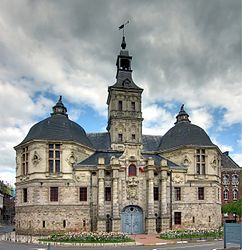Saint-Amand-les-Eaux
This article has multiple issues. Please help improve it or discuss these issues on the talk page. (Learn how and when to remove these template messages)
|
Saint-Amand-les-Eaux | |
|---|---|
 One of the abbey buildings in Saint-Amand-les-Eaux | |
| Coordinates: 50°26′55″N 3°25′41″E / 50.4486°N 3.4281°E | |
| Country | France |
| Region | Hauts-de-France |
| Department | Nord |
| Arrondissement | Valenciennes |
| Canton | Saint-Amand-les-Eaux |
| Intercommunality | CA Porte du Hainaut |
| Government | |
| • Mayor (2020–2026) | Alain Bocquet[1] (PCF) |
| Area 1 | 33.81 km2 (13.05 sq mi) |
| Population (2021)[2] | 15,980 |
| • Density | 470/km2 (1,200/sq mi) |
| Demonym(s) | Amandinois, Amandinoise |
| Time zone | UTC+01:00 (CET) |
| • Summer (DST) | UTC+02:00 (CEST) |
| INSEE/Postal code | 59526 /59230 |
| Elevation | 14–39 m (46–128 ft) (avg. 17 m or 56 ft) |
| 1 French Land Register data, which excludes lakes, ponds, glaciers > 1 km2 (0.386 sq mi or 247 acres) and river estuaries. | |
Saint-Amand-les-Eaux (French pronunciation: [sɛ̃t‿amɑ̃ lez‿o]; former Dutch: Sint-Amands-aan-de-Skarpe) is a commune in the Nord department, northern France.[3] It lies on the river Scarpe, 12 km northwest of Valenciennes. In French, the town people are named Amandinois (m), Amandinoise (f).[4]
The composer Robert Lannoy (1915–1979) was born in Saint-Amand-les-Eaux.
Population
Graphs are unavailable due to technical issues. There is more info on Phabricator and on MediaWiki.org. |
| Year | Pop. | ±% p.a. |
|---|---|---|
| 1968 | 17,170 | — |
| 1975 | 16,692 | −0.40% |
| 1982 | 16,199 | −0.43% |
| 1990 | 16,776 | +0.44% |
| 1999 | 17,175 | +0.26% |
| 2007 | 16,612 | −0.42% |
| 2012 | 16,836 | +0.27% |
| 2017 | 15,889 | −1.15% |
| Source: INSEE[5] | ||
Heraldry
 |
The arms of Saint-Amand-les-Eaux are blazoned: Vert, a sword argent hilted Or between 2 fleurs de lys Or.
|
Local culture and heritage
Industries
Saint Amand has an industrial belt,
The Tower
The tower on the Grand'Place standing 82 metres tall is the symbol of this town. It is one of the remaining structures of the former
The clock with roller and the
The Echevinage

Named
Saint Martin's church
On the place of the actual church there was a Saint Martin's Mont des Cornet, at the 7th century and romance church in the 11th century.
The ancient faience factories
Saint Amand is known for its faience, produced, in the past, by ancient faience factories who was used the bianco sopra bianco technical.
- 1705 Nicolas Demoutier built a faience factory, managed by himself and by the family Dorez, descendants of Bartélémy a ceramist from Lille, in the next place. The faience factory equipment was sold to Bécart in 1775, who has been installed this firm in Valenciennes.
- 1718, the Fauquez family built their faience factory. They were natives of to cross the frontier. The Fauquez's factory was closed in 1794.
Sister cities
 Andernach, Germany since 1959.
Andernach, Germany since 1959. Dimona, Israel since 1966.
Dimona, Israel since 1966. Tivoli, Italy since 2001.
Tivoli, Italy since 2001. Irvine, Scotland
Irvine, Scotland
See also
References
- ^ "Répertoire national des élus: les maires" (in French). data.gouv.fr, Plateforme ouverte des données publiques françaises. 6 June 2023.
- ^ "Populations légales 2021". The National Institute of Statistics and Economic Studies. 28 December 2023.
- ^ INSEE commune file
- ^ Nord, habitants.fr
- ^ Population en historique depuis 1968, INSEE
- ^ Base Mérimée: Ancienne église abbatiale, Ministère français de la Culture. (in French)
- ^ bancloque is the French writing of the Dutch/Flemish word banklokke. A banklokke (i.e. public announcement bell) was used by local authorities to gather people for announcements. (Cf. Van begin 14de tot begin 15de eeuw deed de klok dienst als banklokke, waarbij ban bekendmaking betekent. from: klokke-roeland.nl)




